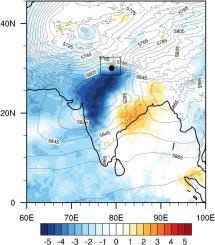Dynamics of Atmospheres and Oceans ( IF 1.9 ) Pub Date : 2021-01-27 , DOI: 10.1016/j.dynatmoce.2021.101202 Babitha George , Govindan Kutty

|
Forecast Sensitivity of an extreme rainfall event over the Uttarakhand state located in the Western Himalayas is investigated through Ensemble-based Sensitivity Analysis (ESA). ESA enables the assessment of forecast errors and its relation to the flow fields through linear regression approach. The ensembles are initialized from an Ensemble Kalman Filter (EnKF) Data Assimilation in Weather Research and Forecast (WRF) model. ESA is then applied to evaluate the dynamics and predictability at two different days of the extreme precipitation episode. Results indicate that the precipitation forecast over Uttarakhand is sensitive to the mid-tropospheric trough and moisture fields for both the days, in general. The day 1 precipitation shows negative sensitivity to the trough over upstream regions of the storm location while in day 2, the sensitive region is found to be located over the southward intruded branch of the mid–tropospheric trough. Perturbations introduced in the initial conditions (IC) over the most sensitive region over the west of the storm location indicate significant variations in the forecast location of precipitation. IC perturbed experiments show that the perturbation amplitude is correlated linearly with predicted change in precipitation, which becomes nonlinear as the forecast length increases. ESA performed on convection-permitting ensembles show that precipitation over the Uttarakhand is mostly non-convective. However, when the location of the response function box is moved north-westward of the Uttarakhand, the sensitivity patterns show signs of convection.
中文翻译:

2013年6月喜马拉雅山极端降雨事件的集合敏感性分析
通过基于集合的敏感性分析(ESA),对位于喜马拉雅山脉西部的北阿坎德邦州的极端降雨事件的预报敏感性进行了研究。ESA可以通过线性回归方法评估预测误差及其与流场的关系。集成是从天气研究和预报(WRF)模型中的集成卡尔曼滤波器(EnKF)数据同化中初始化的。然后将ESA应用于评估极端降水事件两天的动态和可预测性。结果表明,总体而言,对北阿坎德邦的降水预报在这两天对中对流层低谷和湿度场均敏感。第1天的降水对风暴位置上游区域的低谷显示出负敏感性,而在第2天,发现敏感区域位于对流层低谷的向南侵入分支之上。在风暴条件以西最敏感区域的初始条件(IC)中引入的扰动表明,降水的预测位置存在显着变化。IC的扰动实验表明,扰动幅度与降水的预测变化线性相关,随着预测长度的增加,扰动幅度变为非线性。在对流允许的合奏上进行的ESA分析表明,在北阿坎德邦的降水大部分是非对流的。但是,当响应功能框的位置向北阿坎德邦西北方向移动时,灵敏度模式会显示对流迹象。在风暴条件以西最敏感区域的初始条件(IC)中引入的扰动表明,降水的预测位置存在显着变化。IC的扰动实验表明,扰动幅度与降水的预测变化线性相关,随着预测长度的增加,扰动幅度变为非线性。在对流允许的合奏上进行的ESA分析表明,在北阿坎德邦的降水大部分是非对流的。但是,当响应功能框的位置向北阿坎德邦西北方向移动时,灵敏度模式会显示对流迹象。在风暴条件以西最敏感区域的初始条件(IC)中引入的扰动表明,降水的预测位置存在显着变化。IC的扰动实验表明,扰动幅度与降水的预测变化线性相关,随着预测长度的增加,扰动幅度变为非线性。在对流允许的合奏上进行的ESA分析表明,在北阿坎德邦的降水大部分是非对流的。但是,当响应功能框的位置向北阿坎德邦西北方向移动时,灵敏度模式会显示对流迹象。IC的扰动实验表明,扰动幅度与降水的预测变化线性相关,随着预测长度的增加,扰动幅度变为非线性。在对流允许的合奏上进行的ESA分析表明,在北阿坎德邦的降水大部分是非对流的。但是,当响应功能框的位置向北阿坎德邦西北方向移动时,灵敏度模式会显示对流迹象。IC的扰动实验表明,扰动幅度与降水的预测变化线性相关,随着预测长度的增加,扰动幅度变为非线性。在对流允许的合奏上进行的ESA分析表明,在北阿坎德邦的降水大部分是非对流的。但是,当响应功能框的位置向北阿坎德邦西北方向移动时,灵敏度模式会显示对流迹象。









































 京公网安备 11010802027423号
京公网安备 11010802027423号